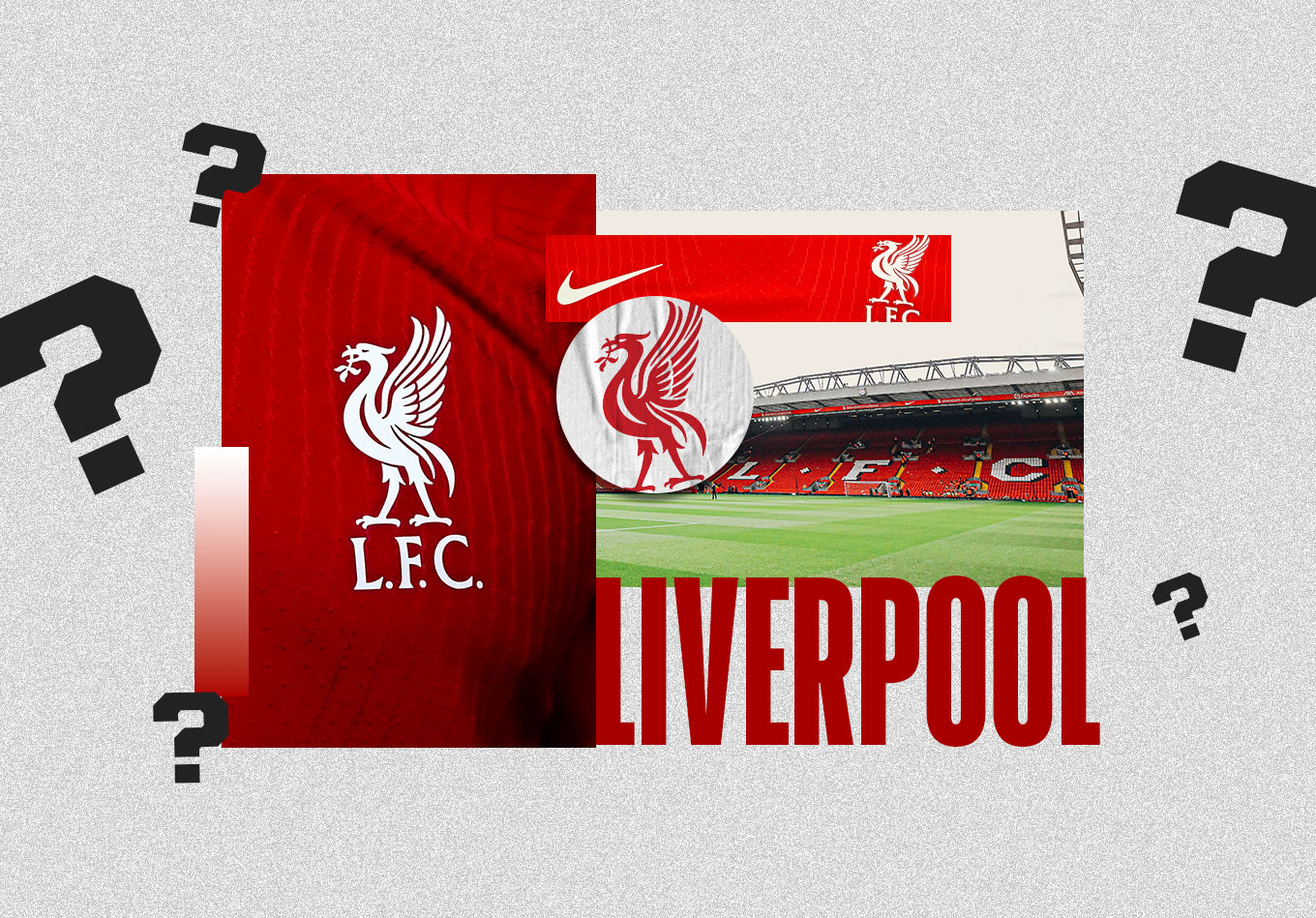After coming close to winning an unprecedented quadruple in 2021-22, it was a very disappointing 2022-23 campaign for Liverpool. The Community Shield was the only silverware they came away with, not even finishing in the top four by the season’s end. Jürgen Klopp has lost some of his most trusted players, but also has some shiny new toys to play with as he looks to get his team back to challenging in the Premier League. Here, we look at five key questions for Klopp in our Liverpool 2023-24 preview.
Can the New Midfield Fire From the Off?
Liverpool’s midfield feels like the subject of one of those television home renovation shows. The one where something that hasn’t been restored in several years suddenly gets a complete makeover. Having signed just one midfielder since 2018 prior to this summer (Thiago Alcântara in 2020), Liverpool look like they will be procuring at least three in the space of a couple of months.
It’s out of necessity, having lost James Milner, Naby Keïta, Alex Oxlade-Chamberlain, Jordan Henderson and Fabinho since the end of last season.
That is a lot of experience heading out the exit door, so far replaced by Alexis Mac Allister and Dominik Szoboszlai, while the club are reportedly also pursuing Southampton teenager Roméo Lavia. Liverpool’s own youngsters, Curtis Jones, Harvey Elliott and Stefan Bajcetic, will be expected to step up as well.
It was an area that certainly needed extensive work. Many laid the blame for Liverpool’s insipid 2022-23 campaign at the feet of the midfield, who so often looked to be outrun and outfought, especially in away games.
Though Jürgen Klopp has always put the emphasis on his full-backs to provide assists and his forwards to score goals, his midfield really didn’t contribute enough going forward. There were just eight goals scored for Liverpool by midfielders last season in the Premier League, and that’s including Fabio Carvalho (two), who is spending next season on loan at RB Leipzig.
That would be fine if the midfield was at least looking after the ball and protecting the defence, but that didn’t seem to be the case either. Only Thiago (57.7%) won more than 50% of his duels, while the Spaniard was also the only Liverpool midfielder to feature in the top 30 for interceptions per 90 of midfielders who played at least 18 games. That the former Barcelona and Bayern Munich man was only able to make 18 appearances in the league was also a problem.
Each of Mac Allister (57.3%), Szoboszlai (50.9%) and Lavia (56.2%) won more than half of their duels in league games last season, while the first two put up 26 goal involvements between them.
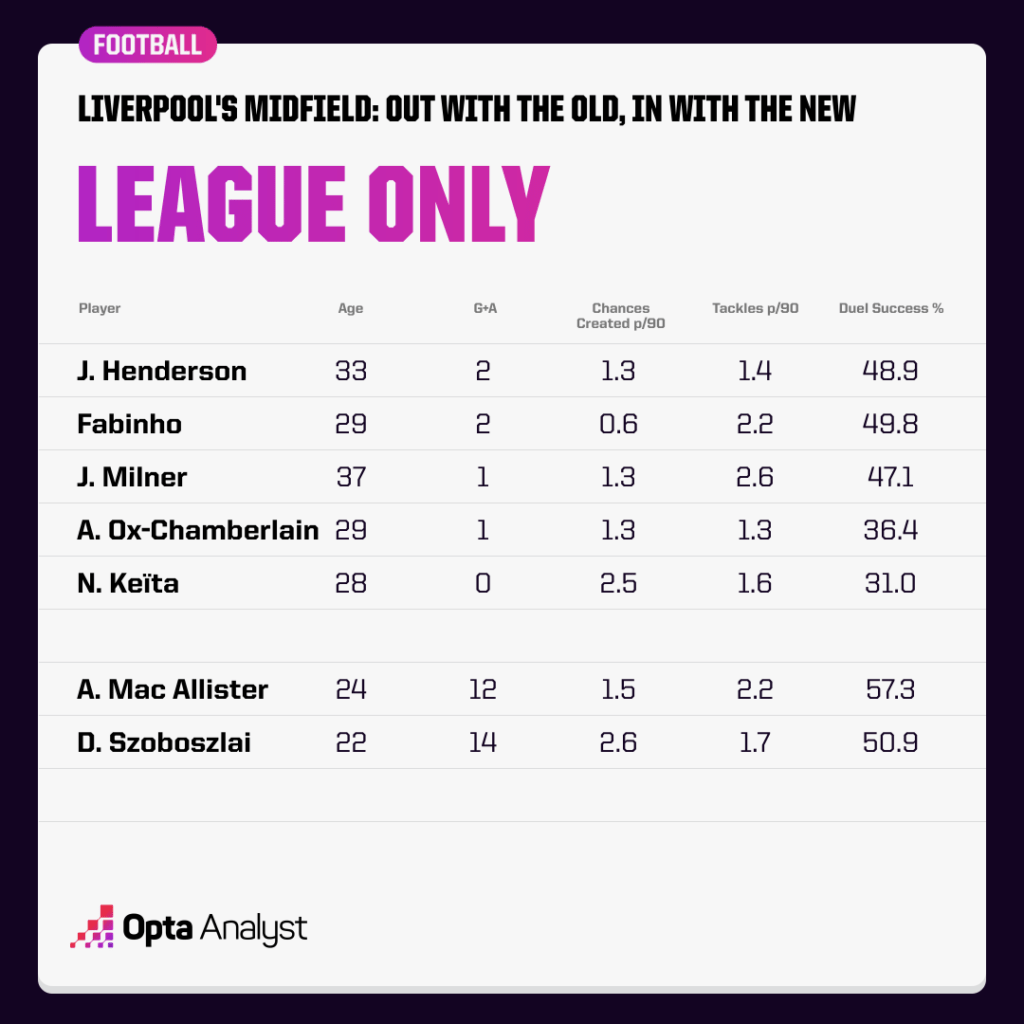
By the end of last season, Liverpool’s midfield had an average age of 27.6 (not including Arthur Melo, who was only on loan and played just 13 minutes in total). Should they be successful in landing Lavia, at the start of the next campaign, their midfield options will have an average age of just 22.4, with Thiago (32) the only player over the age of 24, and just two of their seven options over the age of 22. That will obviously change if Trent Alexander-Arnold is permanently moved into midfield, but you could also argue that any further midfield signing before the window shuts beyond Lavia should probably be someone to add a bit more experience.
Klopp must decide if he is going to trust the new arrivals to hit the ground running or look to bed them in slowly with the likes of Thiago, Jones and Elliott perhaps getting more minutes early in the campaign, though Mac Allister in particular has looked sharp and comfortable in pre-season.
Liverpool have lost a lot of experience and leadership this summer, which was invaluable in recent years, but it must be said, it didn’t help them much last season. They have no choice but to embrace the brave new world with what they hope will be a brave new engine.
How to Get the Best out of Trent Alexander-Arnold?
After being one of the best right-backs in world football in recent years, Alexander-Arnold’s drop off in form was as alarming as anyone’s at Anfield last season. He was widely criticised for his defending, though it was probably the dip in his numbers going the other way that should have raised more eyebrows.
Defensively, Alexander-Arnold committed just two errors that led to shots in the Premier League all season, and none that led to goals. Prior to the home draw with Arsenal in early April, only four Premier League defenders who had played at least 15 games by that point had a better tackle success percentage than his 73.2%, while he had been dribbled past by an opponent just 20 times, 15 fewer than Newcastle United’s Kieran Trippier.
There is only so much that numbers can tell you though, and anyone watching Liverpool’s games will have seen a player struggling with confidence and consistency.
What was more shocking though was that a player who had recorded 12 league assists the previous season had just two to his name in his first 27 league outings in 2022-23. However, Klopp decided to change his role ahead of April’s Arsenal game, where he drifted into midfield when Liverpool had possession. Alexander-Arnold set up Roberto Firmino for a late equaliser against the title challengers, which was the first of seven assists in 10 games, while he also had the most touches of any player in the league in that period (1,073), 122 more than the next most, Brighton’s Lewis Dunk.
He also registered the second-most instances of possession won (80) behind only Manchester United’s Casemiro (89) in that time, suggesting it also aided his defensive game.
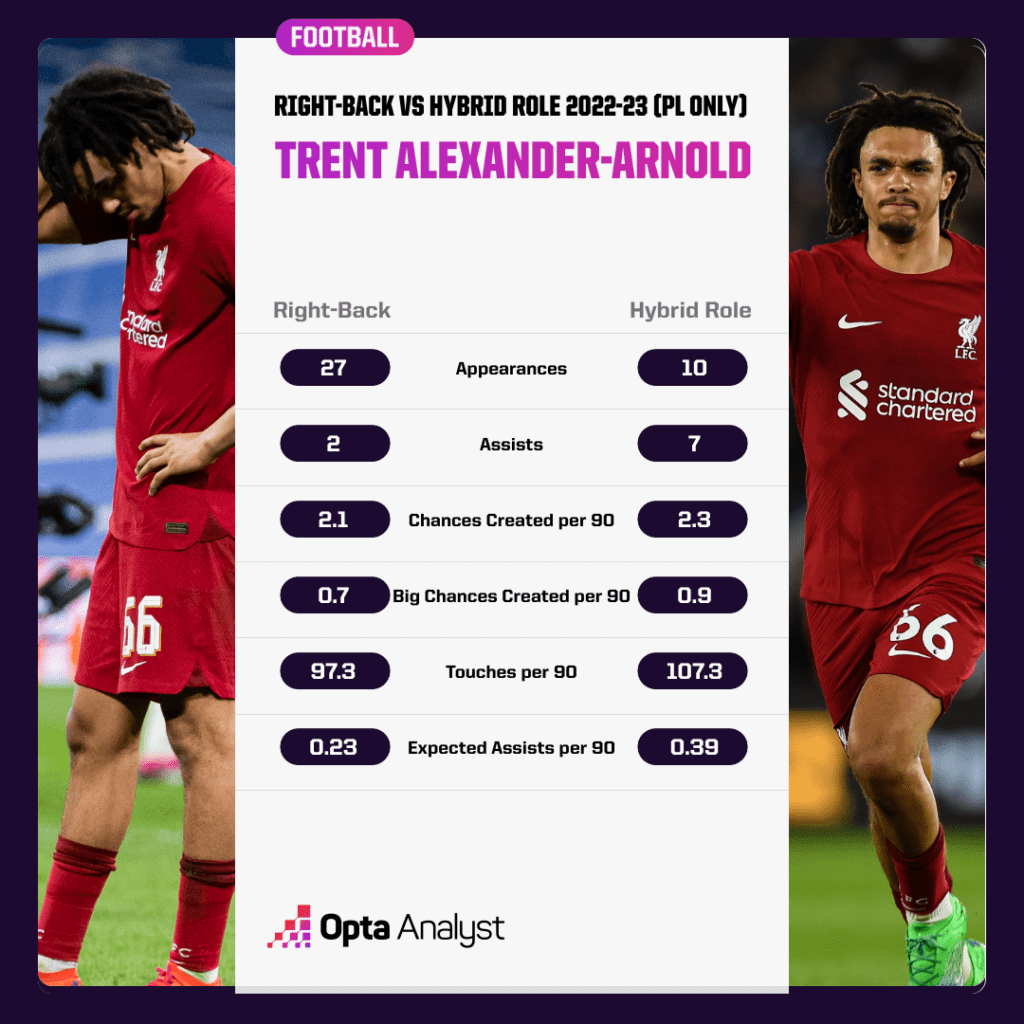
Given the drastic improvement of the player and team after that adjustment, you would assume Klopp will stick with it in 2023-24. Following the system change, Liverpool won more points (24) than any side apart from champions Man City (25) across the last 10 games.
Early signs from pre-season suggest the manager will indeed keep faith with that formation. Alexander-Arnold actually played as an orthodox defensive midfielder in the first two pre-season games, though that was presumably more because of a lack of other options rather than a sign of moving him permanently. He was back in his familiar position for games against Leicester City and Bayern Munich on the tour of Singapore.
Is the Defence Strong Enough?
The midfield may have been the focus of the summer work so far, but concerns also remain in defence.
Liverpool were especially leaky at the back last season, allowing 370 shots at their goal in the Premier League, 73 more than the previous campaign and the most in a full season since Klopp’s arrival in 2015. They were also conceding high-quality chances, with 27.8% of shots faced being classed as big chances, comfortably the most in the Klopp era. They faced just 53 big chances in 2021-22, the fifth fewest in the league, but that almost doubled in 2022-23 (103), the third-most behind only Leeds United and Fulham (both 112).
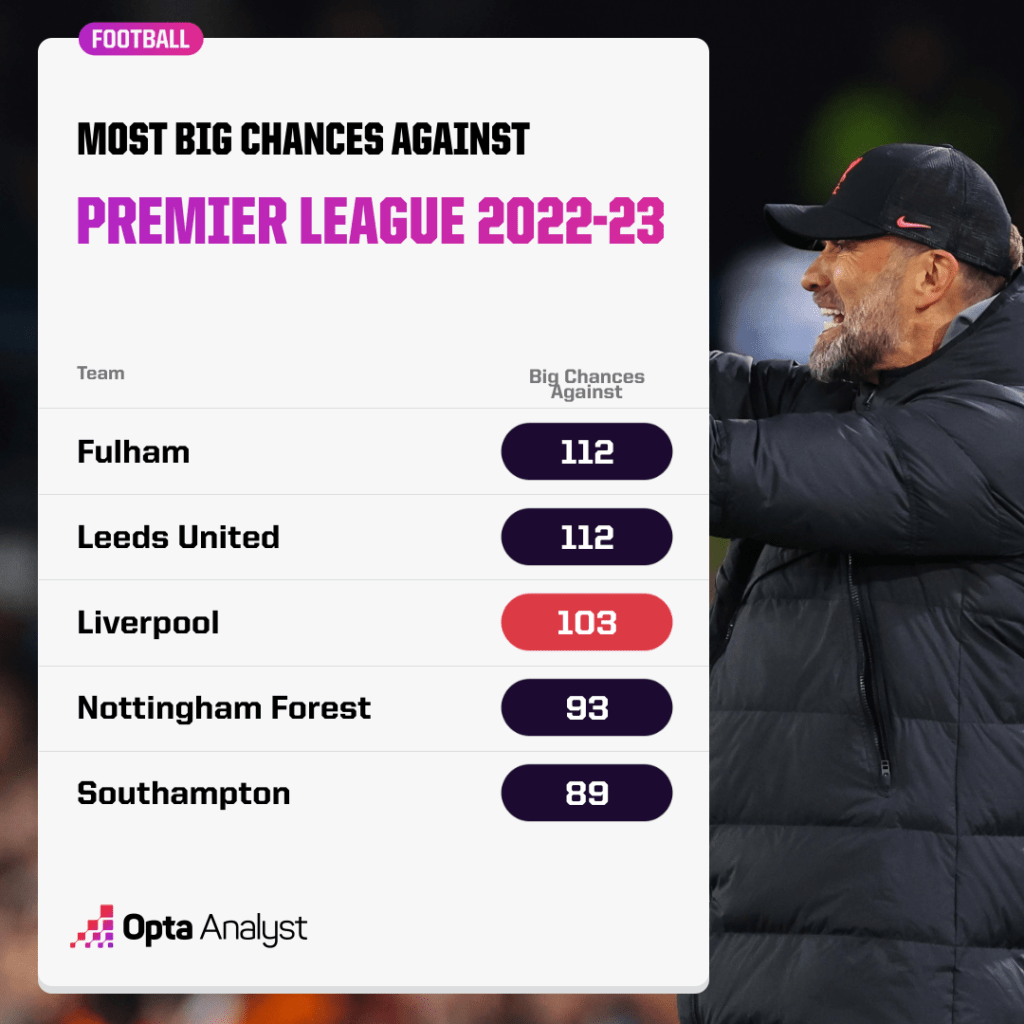
That isn’t necessarily just the fault of the defence, though. As mentioned, the midfield didn’t provide much protection and Klopp also referenced during the campaign how his team’s defending from the front had suffered, likely due to new faces in that area of the pitch adapting.
However, their centre-back options include Joël Matip and Virgil van Dijk, both in their 30s, Joe Gomez, who hasn’t played at a consistently high level since the title-winning 2019-20 season largely due to injuries and struggling to get back into the team, and Ibrahima Konaté, who has done well since arriving from RB Leipzig two years ago but who has only been able to play 29 league games in that time, also due to injuries.
If they stick with the new system, the right-sided centre-back will be required to cover more ground due to Alexander-Arnold’s marauding into midfield, while Andy Robertson at left-back was having to play more like a left-sided centre-back, so perhaps a more natural fit in that area is needed as Liverpool do not currently have a left-footed centre-back.
They have continued to leak goals in pre-season, conceding four in friendlies against both Greuther Fürth and Bayern Munich, though the first of those games saw all four goals conceded in the second half when Liverpool had an unfamiliar backline and goalkeeper. Bayern took advantage of the big gaps on the right side of their defence during the Bundesliga champions’ 4-3 win in Singapore, though.
The club surely needs to bring in at least one defender before the window closes, especially after losing Fabinho who was an emergency option at centre-back, where he was often deployed in the 2020-21 season. They will certainly not want to find themselves in the situation they were that year.
Who Will Make up the Forward Line?
There’s less concern about the forward options, the one area it feels like Liverpool have adequately future-proofed.
Sadio Mané, Divock Origi and Roberto Firmino have all departed in the last year, but Luis Díaz, Darwin Núñez and Cody Gakpo have come in across the previous three transfer windows. Along with Mohamed Salah and Diogo Jota, they make up one of the strongest attacking quintets in Europe.
It will arguably be the best depth Klopp has ever had in that area of the pitch, previously relying on the iconic front three of Mané, Firmino and Salah, with the likes of Origi, Xherdan Shaqiri and Takumi Minamino providing decent if unremarkable back-up. Now he has just Salah left, with four other options who could each conceivably start any game and who all offer something a bit different.
Creatively, Liverpool did not really dip despite losing Mané last summer. Only Man City (103) created as many as their 103 big chances in the Premier League, but it was the finishing of those chances that let them down. Only five teams had a worse conversion rate than their 37.6%, with Arsenal scoring two more big chances than Liverpool’s 47 despite creating 30 fewer overall.
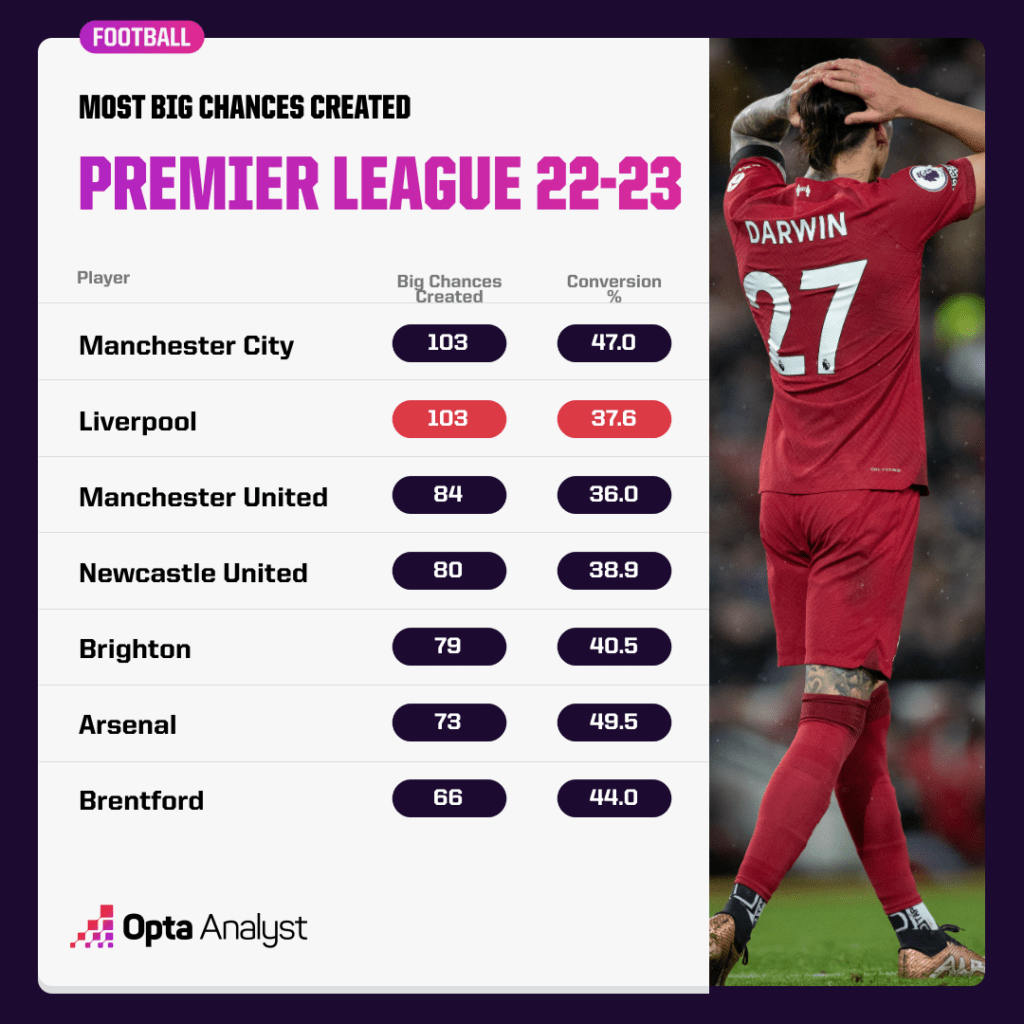
Gakpo showed promise after arriving from PSV Eindhoven in January and Jota improved in the last few games when he got up to speed after a long-term calf injury. Díaz also had his season hugely disrupted by a knee injury, but Klopp will be hoping the Colombian can stay fit and get back to the form that saw him score 14 goals in 18 league games for Porto in the first half of 2021-22 prior to his move to Liverpool.
Similarly, if Núñez can get back to the lethal finisher who scored 21 from 35 big chances (60%) in the Primeira Liga in 2021-22, goals shouldn’t be as much of an issue next season. Núñez does have a history of taking a year to find his feet at a new club, hitting six goals in 29 appearances (19 starts) for Benfica in 2020-21, before upping that dramatically to 26 goals in 28 appearances (24 starts) the following season.
Jota had gone a full calendar year without scoring by the time he struck his first goal of the 2022-23 season in the 6-1 demolition of Leeds in April. He went on to finish the campaign with seven goals, scoring all of them in his last nine games – only five of which were starts and more than any of his teammates in that time – and the Portugal international has continued to look sharp in pre-season.
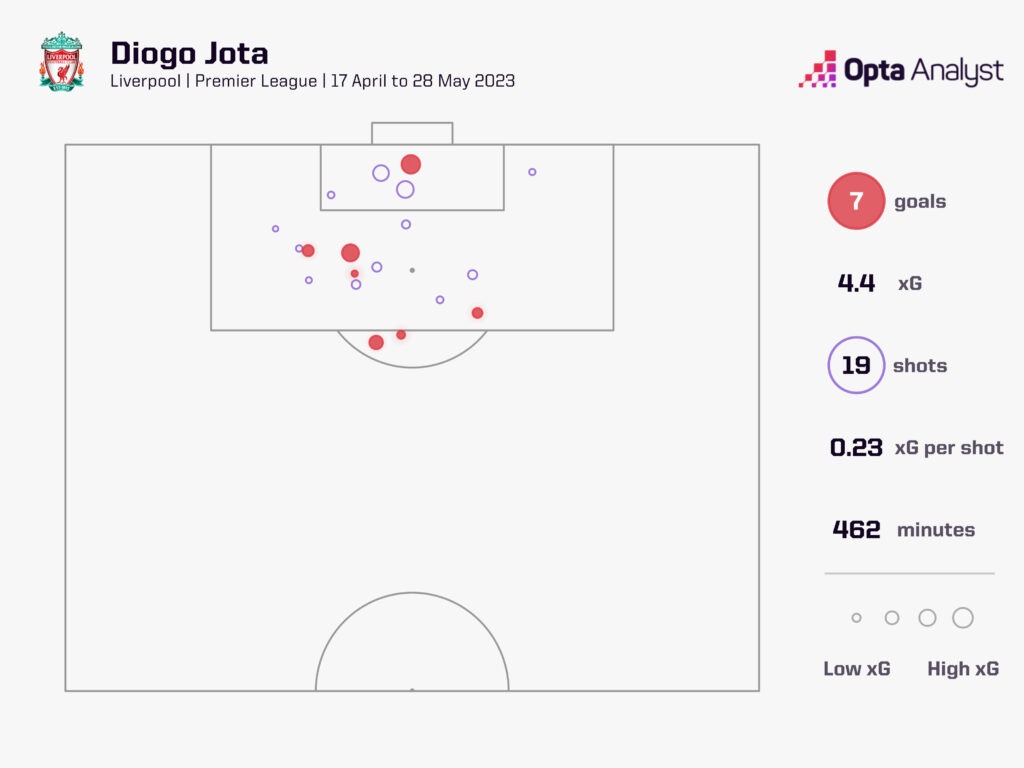
The trick for Klopp is to know which of his options to use and when. You would assume there will be plenty of rotation, with Salah on the right the only guarantee, injury permitting, and there is a ‘horses for courses’ feel about the rest.
There is also exciting 17-year-old Scottish winger Ben Doak to consider, who should be able to offer a threat off the bench and potentially allow Salah some rest here and there. The Egyptian will be going to the Africa Cup of Nations in January/February, and you would think Doak, along with Szoboszlai and perhaps even Elliott, will be wanting to put themselves in a position to step in for that month.
How Seriously Should the UEFA Europa League Be Taken?
One place where Doak may get his opportunities is in the Europa League. For the first time in a full season under Klopp, Liverpool failed to qualify for the UEFA Champions League. They had a lot of fun in the Europa League in his first season at Anfield, but the question is will they try and avenge that 2015-16 campaign when they lost to Sevilla in the final, or will they treat it as a chance to give young/fringe players a run out?
Both can be true, of course. Arsenal and Manchester United made numerous changes to their teams in the group stage last season, and you would be surprised if the likes of Van Dijk, Alisson and Salah were playing in the competition much, if at all, before the knockout rounds.
Whereas in a Champions League campaign you would expect changes to be minimal – Klopp made just three for the first group game at Napoli last season after a goalless draw against Everton in the previous game – the Europa League should allow the German to rest more of his key players. For example, Mikel Arteta made seven changes for Arsenal’s first group game away to FC Zurich last season following the 3-1 Premier League defeat at Man Utd.
With competition so fierce in the Premier League, Liverpool cannot dismiss the fact that winning the Europa League is a second opportunity to qualify for the Champions League. A season out of Europe’s top club competition is one thing, but two in a row would be cause for concern.
Liverpool fans love European nights, and the older generations will tell you plenty of their best were in the UEFA Cup. The last time they won the competition was in 2001, when they had a midfielder called McAllister.
It also remains the only competition Liverpool have competed in under Klopp and not won.
Winning often begets winning – as this team knows all too well – and they will be keen to get that habit back in 2023-24.
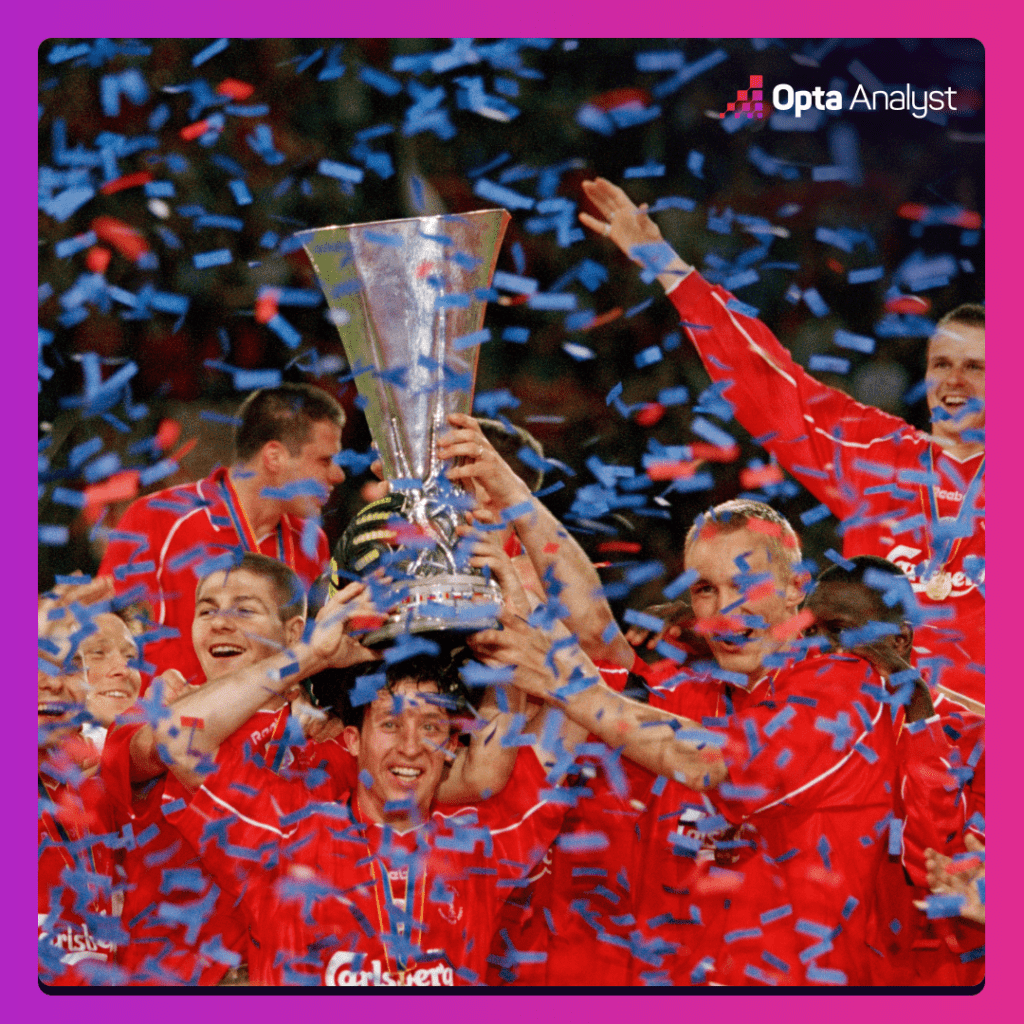
You want to read more Premier League season previews? Click on the links below:
Manchester United
Chelsea
Arsenal
Manchester City
Newcastle United
Tottenham Hotspur
Enjoy this? Subscribe to our mailing list to receive exclusive weekly content. And follow us on Twitter too.
